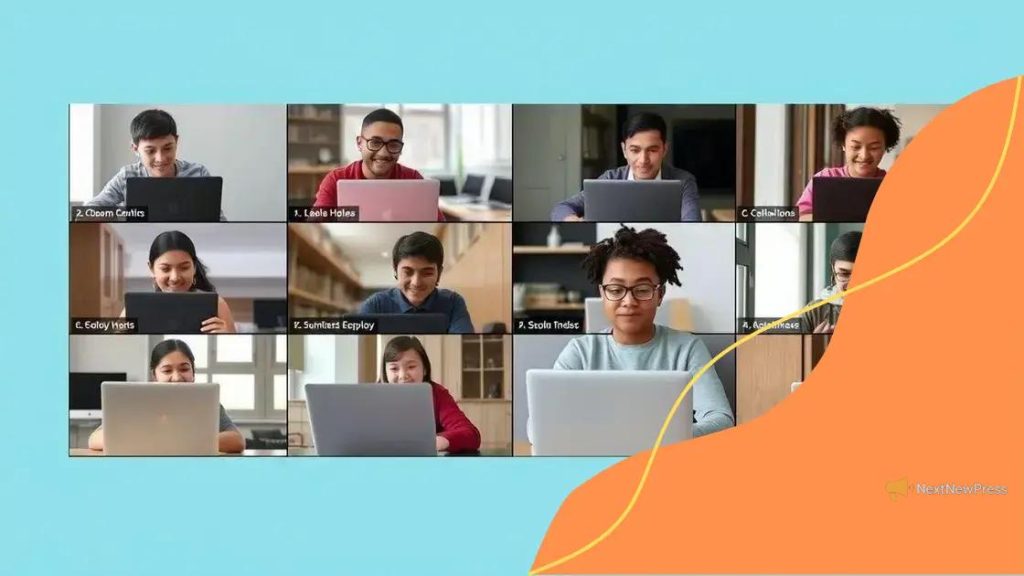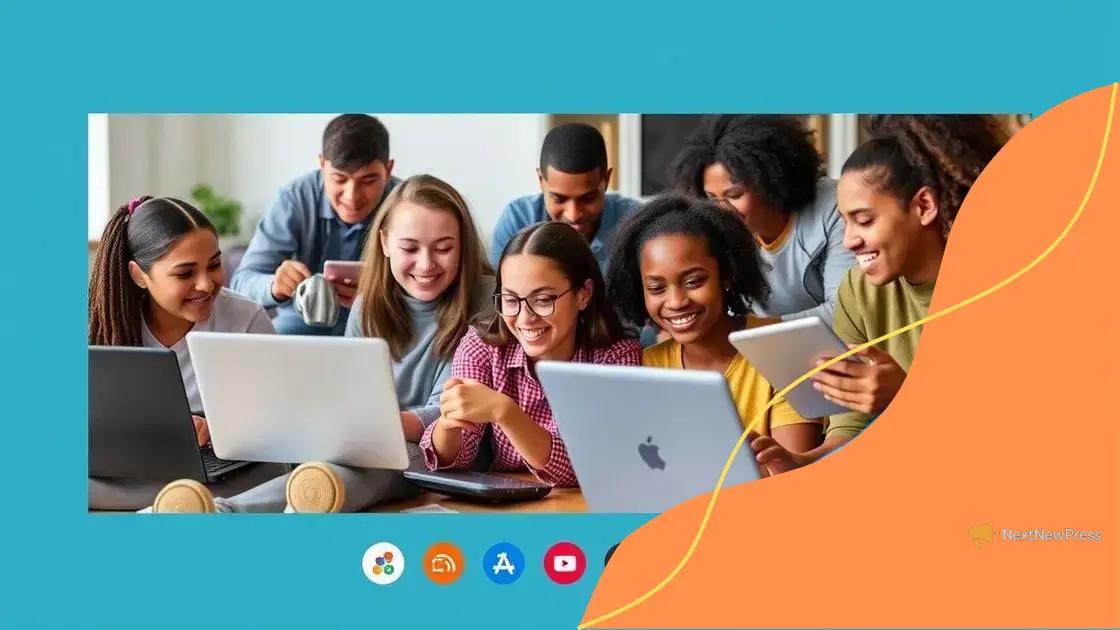The role of virtual exchange programs in global education

The role of virtual exchange programs in global education is to connect students across cultures, enhance collaborative skills, and promote intercultural understanding through technology, overcoming geographical barriers.
The role of virtual exchange programs in global education is becoming increasingly significant as technology bridges global divides. Ever wondered how these programs enhance learning experiences? Let’s explore the transformative power of virtual exchanges.
Understanding virtual exchange programs
Understanding virtual exchange programs is essential in today’s globalized world. These programs offer unique opportunities for students to engage with peers from different cultures without leaving their homes. By participating in virtual exchanges, students can enhance their educational experience and develop critical global skills.
Defining Virtual Exchange Programs
At their core, virtual exchange programs use digital communication tools to connect learners from various backgrounds. These initiatives are designed to foster intercultural dialogue and collaboration through structured learning activities.
Key Features of Virtual Exchange Programs
- Intercultural learning experiences
- Collaboration on projects with international peers
- Access to diverse educational resources
Moreover, these programs often integrate real-world issues that encourage students to work together on solutions. For instance, a common project might involve tackling environmental concerns, which not only enhances their learning but also fosters a sense of global responsibility among participants. These interactive elements are vital as they promote deeper learning and understanding across cultures.
Benefits of Participating in Virtual Exchanges
The benefits of virtual exchange programs extend beyond mere knowledge acquisition. They help students improve their communication skills and develop a global mindset. Engaging with peers from different countries allows students to challenge their own perspectives and consider new ideas.
- Improved language skills through conversation practice
- Increased cultural awareness and empathy
- Enhanced critical thinking and problem-solving abilities
Students involved in these exchanges often report feeling more confident in their ability to work in diverse groups and think critically about global issues. By understanding different viewpoints and customs, participants are better equipped to succeed in an increasingly interconnected world.
Technology’s Role in Virtual Exchanges
Technology plays a crucial role in the success of virtual exchange programs. Tools like video conferencing, social media, and collaborative platforms help facilitate communication and project work between students. These technologies make it easier for learners to share ideas and experiences, bridging geographical gaps.
While some challenges may arise, such as time zone differences or varying internet access, the potential benefits far outweigh these obstacles. With the right support and resources, students can overcome these challenges to enjoy a rich learning experience.
Benefits for students and educators
The benefits of virtual exchange programs extend to both students and educators in meaningful ways. For students, these opportunities provide unique platforms for growth, learning, and collaboration across cultural lines. Meanwhile, educators can enhance their teaching methodologies and gain insights into diverse educational practices.
Enhancing Student Skills
Through virtual exchange programs, students can develop essential skills that are vital in today’s interconnected world. These skills include:
- Effective communication across cultures
- Collaboration with peers from various backgrounds
- Increased adaptability in different environments
Participating in these programs enables students to engage in discussions that promote critical thinking and perspective-taking. They learn to articulate their thoughts while also respecting and understanding others’ viewpoints. This process fosters a sense of global citizenship and empathy as students interact with peers worldwide.
Benefits for Educators
Educators also see significant advantages when implementing virtual exchange programs. They can:
- Access international teaching resources and practices
- Enhance their curriculum through global perspectives
- Engage with colleagues worldwide for professional development
This engagement allows teachers to innovate their lesson plans, integrating global issues and perspectives into their classrooms. By experiencing different educational environments, educators can bring fresh ideas and practices back to their home institutions, ultimately enriching the learning experience for all students.
Moreover, these programs foster collaboration between educators in different nations, leading to shared knowledge and resources. As a result, teachers are better equipped to support diverse learners and adapt to emerging trends in education.
Cultivating Lifelong Relationships
Both students and teachers benefit from the relationships built through virtual exchange programs. These connections often lead to lasting friendships and professional networks, helping participants expand their horizons and appreciate cultural diversity. The bonds formed during these exchanges can encourage a deeper understanding of global issues and inspire individuals to become advocates for positive change.
Technological tools that facilitate virtual exchange

Technological tools play a vital role in facilitating virtual exchange programs, making it easier for students to connect and collaborate across the globe. These tools enable seamless communication and enrich the learning experience, ensuring that geographical barriers do not hinder education.
Essential Tools for Virtual Exchange
Various platforms and applications are designed to enhance interaction among participants. Some key tools include:
- Video Conferencing Software: Applications like Zoom and Google Meet allow real-time discussions and group activities.
- Collaboration Platforms: Tools such as Google Docs and Trello help teams work together on projects, sharing ideas and resources efficiently.
- Online Forums: Discussion boards and forums enable ongoing conversations and relationship-building among peers.
Each of these tools serves a unique purpose, creating an engaging learning environment that encourages dialogue and collaboration. These technologies not only facilitate learning but also enhance the overall experience by making it more interactive and enjoyable for students.
Benefits of Using Technology
The integration of technology in virtual exchange programs brings numerous benefits. These include improved engagement, increased access to resources, and the ability to connect with experts worldwide. Students can participate in workshops, guest lectures, and cultural exchanges without the need for physical travel.
Technology also allows students to learn from different educational perspectives. For example, they can use platforms like Padlet to share ideas and discuss global issues creatively. This not only broadens their horizons but also enriches their understanding of complex topics.
Overcoming Challenges with Technology
While technology facilitates many aspects of virtual exchange programs, challenges such as technical difficulties and varying levels of access can arise. Educators need to ensure that all participants are familiar with the tools and have access to necessary resources. Provide training sessions for students to help them navigate these platforms effectively.
Moreover, it’s important to establish clear communication guidelines. This helps foster a respectful and collaborative online environment where everyone feels valued. By leveraging technology effectively, both students and educators can maximize the benefits of participating in virtual exchanges.
Real-world success stories
Real-world success stories showcase the impactful results of virtual exchange programs and highlight how students and educators benefit from these experiences. These stories inspire others to participate and demonstrate the transformative power of connecting with people from different backgrounds.
Case Study: Global Classroom Project
One successful example is the Global Classroom Project, where schools from various countries partnered to work on sustainability initiatives. Students collaborated on projects that addressed local environmental issues while learning from each other. This exchange helped participants understand global challenges and think critically about solutions.
Student Testimonials
Students who participated in such programs often share their experiences. Many express how virtual exchange programs opened their eyes to different cultures. For instance, one student noted, “Working with peers from another country taught me new perspectives and helped me appreciate diversity.” These firsthand accounts inspire others to engage in similar programs.
- A student in Brazil collaborated with classmates in Japan to create a presentation about renewable energy.
- Participants in a cultural exchange program developed friendships that lasted long after the project ended.
- Teams from various countries successfully organized a virtual festival showcasing their cultures, promoting respect and understanding.
Such stories demonstrate that beyond classroom learning, virtual exchange programs create lasting relationships and friendships. They help students and educators grow personally and academically.
Impact on Educators
Educators also share their own success stories. Many report using insights gained from virtual exchange programs to enhance their teaching methods. For example, a teacher in the United States adapted their curriculum based on strategies learned from peers in Europe, ultimately enriching the educational experience for all their students.
Additionally, educators often collaborate on projects, sharing best practices and resources. This type of professional development enriches their teaching and provides students with diverse learning experiences.
Challenges and solutions in virtual exchanges
Challenges exist in virtual exchange programs, but many solutions can help overcome them. Understanding these challenges is essential for educators and students looking to maximize their experience. The integration of technology brings both opportunities and obstacles that must be navigated carefully.
Common Challenges Faced
One major challenge is technical difficulties. Issues such as poor internet connections or unfamiliarity with software can hinder participation. These technical problems can lead to frustration among students and educators alike. Another challenge is the time zone differences that can make scheduling meetings difficult. Coordinating activities across multiple countries requires careful planning to accommodate everyone involved.
- Limited access to technology and resources
- Lack of experience with collaborative projects
- Cultural misunderstandings and miscommunications
Additionally, some students may face language barriers. This can limit their ability to express ideas and engage with their peers effectively. While many programs strive for inclusivity, these barriers can still pose difficulties for participants.
Effective Solutions
Fortunately, there are effective solutions to address these challenges. Providing training sessions on the technological tools used in virtual exchanges can help ensure that all participants are comfortable using the platforms. Preparing students ahead of time with tutorials or guides can reduce technical issues during collaborative activities.
To tackle time zone differences, scheduling tools like Doodle or Google Calendar can help participants find suitable meeting times. Educators can also plan asynchronous activities that allow students to contribute at their own pace, which can accommodate different time zones and schedules.
Promoting Cultural Awareness
Promoting cultural awareness is another essential solution. Facilitators can encourage students to share information about their cultures and discuss potential misunderstandings openly. This practice fosters empathy and understanding among participants, helping to break down language barriers.
Lastly, building a strong support network of mentors and peers can be beneficial. Experienced educators can guide newcomers through the exchange process, addressing concerns and providing assistance throughout the program. This support can empower students and educators alike, making the most out of their virtual exchange experiences.
In conclusion, virtual exchange programs offer unique opportunities for students and educators alike. These programs not only break down geographical barriers but also provide valuable skills for the modern world. Through collaboration and cultural exchange, participants gain a better understanding of global issues and develop meaningful connections. By addressing challenges with practical solutions and embracing technology, schools can enhance the educational experiences of all involved.
FAQ – Frequently Asked Questions about Virtual Exchange Programs
What are virtual exchange programs?
Virtual exchange programs are collaborative educational experiences that connect students from different countries through technology, fostering intercultural dialogue.
What benefits do students gain from participating in these programs?
Students gain enhanced communication skills, cultural awareness, and the ability to collaborate on global issues, which prepares them for a more interconnected world.
How can technology aid in virtual exchanges?
Technology facilitates real-time communication and project collaboration through tools like video conferencing, sharing documents, and online discussion forums.
What challenges might participants face, and how can they be overcome?
Challenges include technical difficulties and time zone differences. Solutions involve providing training on technology, scheduling tools, and promoting cultural understanding.





